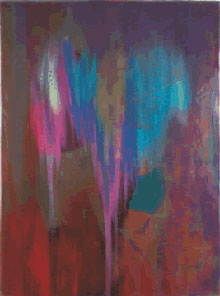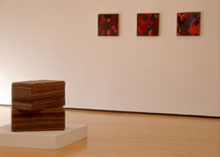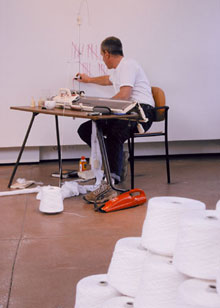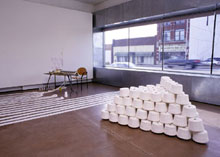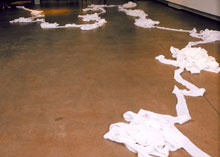Stuart Netsky
January 15 - February 27, 1999
After twenty years of gender theory it is now clear that one can speak of masculine and feminine models without reference to
genital facts or biographical narrative. The latter two realities, the physical and the performative, can be seen as parallel but
separate tracks of thinking, or of classifying real-world phenomena. Stuart Netsky's appropriations and makeup works are best
appreciated as occurring within the space between these two tracks. Considering these works lets us approach the question of
how we actually live after becoming aware of the slipperiness of our gender roles, the contradictory nature of desire, and the
interchangeability of our objects of desire.
Much of our descriptive vocabulary for art is received as already gendered. For example, hard = masculine; soft = feminine.
Rational = masculine; emotional = feminine. None of these terms is de facto pejorative, nor is any one necessarily a term of praise.
In addition, the good/bad balance between masculine and feminine descriptors throughout the history of art has shifted. If the highest
praise for neoclassic painters was given in terms of masculine hardness and rationality, those standards were to be inverted with the
highest remade as the lowest by the romantic painters who would succeed them.
Postwar art, from which Netsky most often appropriates, is a tad more complicated. Abstract Expressionism, mushily emotional and
romantic, was also tragically masculine in its expansion of physical scale and grandness of ambition. Recent scholarship has suggested
that this was tied to the encroaching crisis of masculinity when men returned from war to an arena of changing social realities. The
Ab-Ex artist had to be extra-masculine for fear of being seen as already feminized and sexually compromised. The success of
Ab-Ex in the popular imagination was tied to cold-war political realities which all but demanded that artists be cowboys in order
to be adequately all-American.
Pop was and is a queer phenomenon despite the biographical heterosexuality of about half its geniuses; it is thus one of the areas from
which Netsky never appropriates. In response to Pop came Minimalism, its child Post-Minimalism, and its bizarre stepchild Earth Works.
Despite the active presence of several women, including Mary Miss, Alice Aycock, and Nancy Holt, Minimalism was rightly understood as
a butching-up of art-practice. Earth Art, the primary subject of this Netsky exhibition, was the butchest of all. Any art-practice that has as its
basic tools bulldozers and jeeps is by definition masculinist, but what makes the gender of Earth Art so conspicuous is the scale of its
ambition: art too big to be contained in any gallery. Art so grand it can be seen from the moon. An art that whips Nature, as in uber-chick
Mother Nature, into submission.
Although it was not a massive project in terms of earth-moving, Walter De Maria's Mile Long Drawing was rationalist at heart, with the
straightness of its line and its imposition of masculine, rigid geometries onto the earth. It is also a piece that almost no one saw in person,
and everyone knows the work through the photograph that shows the artist lying down beside it. In its remoteness, its impracticality, its
harsh location, and its survival only as a fetishized photograph it is the perfect reluctant lover, the sailor off at sea after a steamy weekend,
existing only as a memory. These qualities add layers of fascinating perversity to Netsky knitting what looks like a sweater for it, because
it no longer exists. Done live, as performance, Netsky will be knitting the entire mile of the piece. The work will tumble and spill, and its
effect will of course be very different from that of its source. In effect, Mile Long Drawing will be reborn in a cross-dressed version.
Any appropriation is multivalent in relation to its source, and to deconstruct each of the devilishly imbricated and intentionally
contradictory associations of Netsky's piece requires some deliberateness. First it may be read as an act of tribute.
One does not appropriate or quote a work that has no personal significance. One can discern that a longing for the moment of
inspiration, and of completion, was present, and it is made more profound knowing that the work is no longer extant. Even that
knowledge is soured, however, by the presence of an undisguised envy (penis envy perhaps) a coveting that verges on the creepy
when considering the laboriousness of Netsky's act of affection, equivalent to the stalker's love of his/her prey. But to appropriate is
also an act of violation. The earth artists operated on the 'genius' model, which makes the artifact, in this case the documentary
photograph, proof positive of an unrecoverable moment of heroic and radically individuated creativity. Doubling the original action is the
fly in the ointment that calls into question the founding dictums of the genius model; it is a questioning that occurs through seizure of
the intellectual property of another. Starting with Duchamp's ready-mades, moving to Warhol, Johns, and Lichtenstein, on to the hardcore
appropriation of Elaine Sturtevant, Sherrie Levine, and Mike Bidlo, and then to the more recent regenderings of icons of modernity by
artists such as Janine Antoni, Rachel Lachowicz, and Stuart Netsky, the history of appropriation has been actually quite diverse. Just
what is their thievery meant to imply? Like Sturtevant, and as in recent works by Bidlo, Netsky's labor makes clear his devotion to his
sources. Unlike the appropriations of Sherrie Levine, simply rephotographed from books or fabricated by others, Netsky's handwork
splits our response. As I write, the piece has not yet occurred, but I imagine Netsky swamped by the evergrowing mass of his knitting,
like the first of the three fates left unaccompanied, with the two hundred pounds of wool transformed into a monument to his time freely
spent in total devotion. This devotion also makes his authorship earned and therefore unquestionable, the seizure more complete and
unrecoverable. And the theft is akin not to the greedy thief who steals your stereo to resell on the street, but more like the sexy/creepy
sticky hands of the one-night stand who lifts your underwear as a keepsake.
Knitting is an art of the home, whereas De Maria's art was that of the adventurer far from home. One cannot help but think of Netsky as the
adventurer's wife, sitting at home knitting a covering, a warm cozy for the absent beloved's trophy just in case he does return. This image of
the artist awaiting the wanderer, whose return in this case we know is impossible, is itself filled with bathos. Do we understand this as a
heroic devotion, like the dog waiting at its master's grave, mistakenly thinking that he will one day rise? Or do we, in this post-therapy age,
see this as dysfunctional, obsessive longing? If we assign Netsky's activity to one or the other category, what do we reveal about ourselves or
our personal histories? As Netsky's piece develops in its active performed state I am curious what may be revealed by audience members with
regard to their own longings as they chat with the artist, whose boredom and strain during his repetitive task is a given.
We also have for our consideration Netsky's transformations of works by Richard Serra, Paul Cezanne, and Barnett Newman. There are no
direct links among these artists. One cannot plot a straight line through Netsky's choices of who to appropriate from. Netsky instead presents
himself as a wanderer, a cruiser in the art museum, picking and choosing per his own unpredictable attractions and desires. And as we see
with his Mile Long Drawing, his love is fickle as well as bipolar. Serra's two-unit sculpture is remade as bolsters, decorative pillows. Cezanne's
sky-palette becomes a blanket, and Newman's signature Zip is a scarf; each is memorialized, protected while simultaneously trivialized and
made the object of Netsky's mischievous humor. Serra and Newman are often described as prickly, and one doubts that either has ever had
much of a sense of humor about himself and even less about his work. Cezanne was afflicted with such severe self-doubt that he refused to
attend the one retrospective held during his lifetime in case he would be criticized. These three need the protection Netsky offers, but had they
a choice in the matter they would probably be least likely to accept it. Part of our narrative comprehension must involve Netsky's making
himself into the lover who only lets himself fall for guys he is sure will reject him.
Finally we must examine Netsky's makeup abstractions gorgeous paintings made of nail polish, foundation or lipstick. Their appropriative
nature is somewhat obscured by their having no specific sources but rather many sources drawn from a type of lyrical, process-based abstraction.
For Netsky, it is here that art-historians turn from a stable of champions and defenders to a chorus of critics and nitpickers (no pun assumed)
who cannot allow that nail polish and oil paint are in the same category of use, that is, both are applied to surfaces to create visual effects.
We are in fact back .....
Ultimately Netsky's larger project, although here based on knitting, is one of unraveling. He takes apart stitch by stitch the postwar histories that
constructed gendered differences, male/female, gay/straight, as part and parcel of understanding artwork. This is, of course, a bittersweet
phenomenon. It's the swaggering art-cowboy that attracts Netsky, and he and I will both miss the mythologies that filled the air of galleries with
testosterone and ball-sweat. We cannot pretend that we lack the knowledge we have today, but our understanding of the constructedness of
gender will take some getting used to, and Netsky's project is part of that.
Bill Arning
1998
New York, NY
Back to top

|
|




